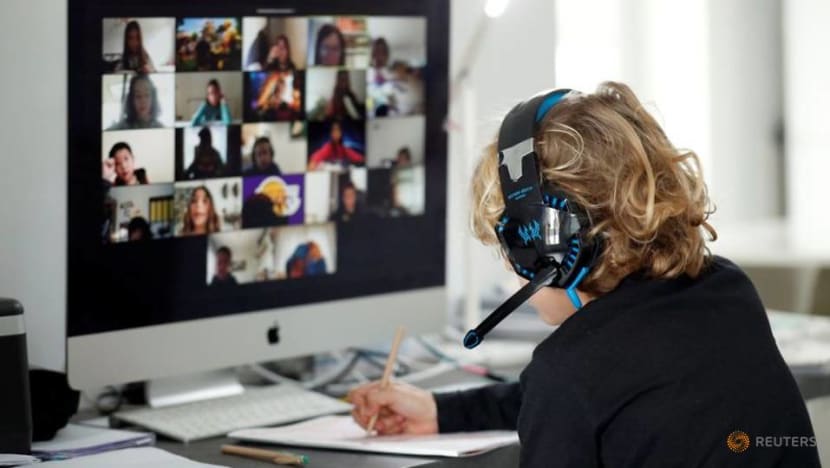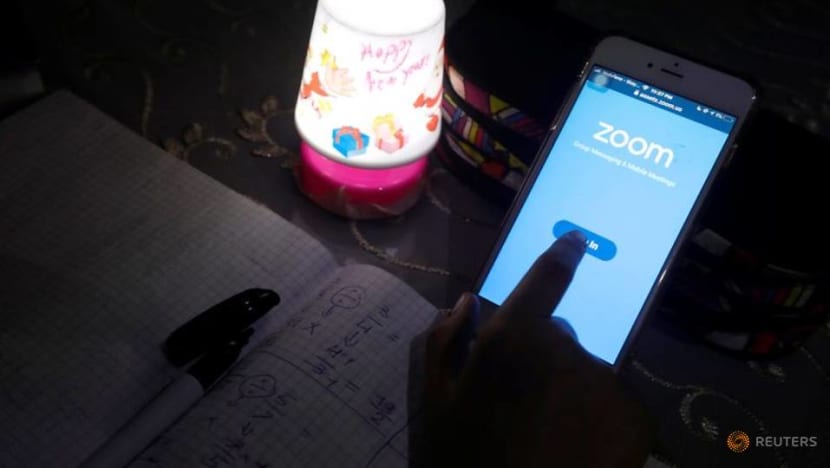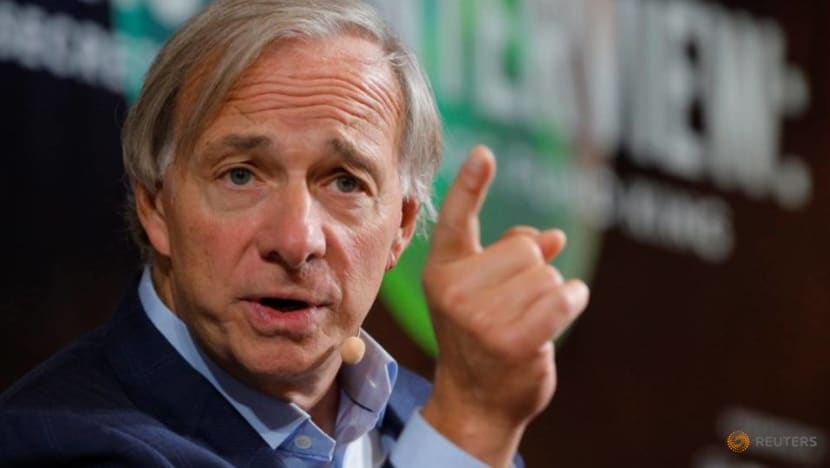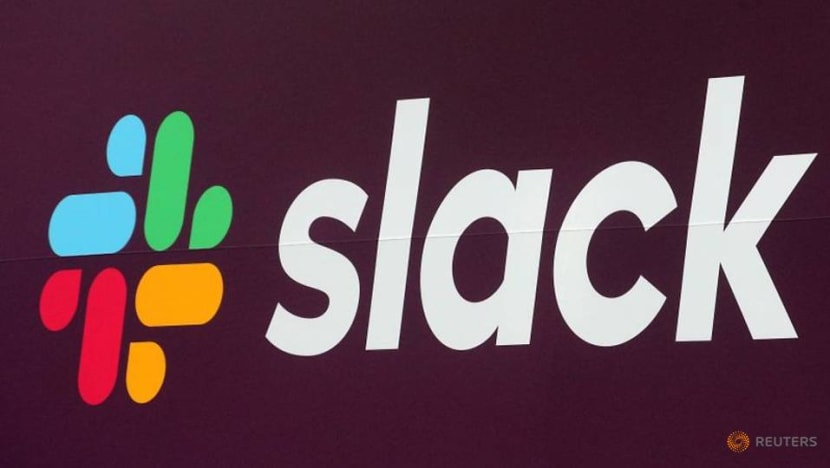commentary Commentary
Commentary: How Zoom-working will change companies forever
Virtual meetings are here to stay. It’ll upend how all corporate decisions are made from here on, says Howard Yu.

A man at home, with his companions, using the Zoom App. (Photo: REUTERS/Albert Gea)
HONG KONG: Like thousands of other professors, the executive education programmes I teach have either been cancelled or migrated over to Zoom, under the shadow of a pandemic.
Just the other day, one of my class participants, John, presented a case study.
“What a Zoombomber,” someone moaned in the chat window for the online class session. The chat window pops its head as more classmates chime in on what they think of the speaker’s opinion. “That’s just so John,” complains another.
READ: Commentary: Remote working promised freedom, but seems to be delivering the exact opposite
READ: Commentary: COVID-19 outbreak reveals poor etiquette in working from home
But here’s where it gets interesting. In the chatbox exchange, John's classmates are not only expressing their opinions of how John is doing but also adjusting their feedback accordingly
All of a sudden, observers are forced to confront the collective and more balanced opinion of others. “Well, I guess he has his reasons for saying so,” someone now says emphatically.
John is receiving this more generous evaluation in large part, I suspect, because he has taken notice of that very chatbox and is using that feedback during the conversation to course-correct the Zoom presentation he is making, in real time.
John’s rhetoric subtly shifts. His words stay bold but come across a little less brash.

And if John were to ask me what I thought of his presentation, I would tell him that he’s been quite attuned to people’s feelings. Thank you, chatbox.
OUR NEW DIGITAL LIBRARY
The inevitable experiment arising from these travel bans and social distancing restrictions is the work-from-home arrangement companies have to embrace en masse and deploy, for instance, video conferences in lieu of face-to-face meetings.
We are, unwittingly, producing a staggering digital library on how managerial decisions are made. Meetings like the one described above are recorded and then stored in the cloud.
Far from minutes of a meeting that summarises only the conclusions, this digital footprint captures the entire deliberation process, from emotion to facts, from tirade to discussion, from opposition to the formation of a consensus.
READ: Commentary: The time of introverts has come as firms ramp up work-from-home arrangements
READ: Commentary: 'BBC Dad' has learnt a thing or two about working from home
That digital library could well contain the key to an explosion in productivity gains, which have fallen for decades.
WHY PRODUCTIVITY HAS BEEN LOW FOR SO LONG
Don’t get me wrong. The impact on work and resulting productivity loss due to social distancing is real, but so are the hidden costs of face-to-face interaction of our previous era.
An executive once told me every time the company prepares the launch of a new product, he has to listen to the briefing from headquarters, and then call up his team to pass out responsibilities.
Each member would then, in turn, find their counterparts — the freight forwarders, the retail stores, the advertising agents — all the while keeping headquarters updated on every milestone. With Excel spreadsheets flying everywhere, everything was done manually.
“Have you been hiring new people?” I asked.
“Absolutely! Thank God business is growing,” he said. “But training is a pain. I hate coaching,” he said.

The more products a firm offers, the more complex its operations becomes, the more people the company needs, the more likely human errors occur, and the more training sessions are required. That’s where things don’t scale.
Is it any wonder why most leaders are stuck clearing their email inboxes at midnight? We see computers everywhere except in the productivity statistics, as Economist Robert Solow said in 1987.
AN EXPERIMENT IN RADICAL TRANSPARENCY
But it doesn’t have to be this way. Enter Bridgewater Associates, the world’s largest hedge fund with around US$160 billion in assets. What its founder Ray Dalio did some thirty years ago seems prescient today.
READ: Commentary: 5 tips to ace leading a team while working from home
READ: Commentary: It’s not just work and the economy. COVID-19 is also changing how we use social media
Before Zoom or WebEx, Dalio sought to videotape every managerial meeting of his company and built a small team to edit the tapes, focusing on the most important moments, and turn them into case studies for employee training.
He called it “radical transparency,” where there are no “closed door” conversations across all ranks.
Even a face-to-face meeting with the head of recruiting where Dalio had to discuss the difficult subject about the lack of reliability in his performance was filmed and made available to the company’s 1,500 employees to view.
This was far from a public shaming of his underlings, when Dalio also gets his own fair share of exposure.
More recently, Bridgewater has developed its own digital apps, including the Dot Collector, which the founder called the company’s “most loved and impactful tool”.

The app is installed on every employee’s company iPad. Employees are expected to bring the iPad to every meeting, giving and receiving real-time feedback on each person’s contributions in the form of “dots,” or data points.
These “dots,” either positive or negative, are made public regardless of the person’s position in the company.
All these “dots” are then reviewed and digested by a computer with a proprietary algorithm. The algorithm then calculates everyone’s “believability” based on their past performance.
So, when Bridgewater needs to make major decisions, opinions from individuals are solicited and weighted based on their dot scores – in other words based on the individual’s merit, not pay grade. Those who have repeatedly proven their grasp of a given topic are given more weight than others.
READ: Commentary: COVID-19’s education revolution - where going digital is just half the battle
READ: Commentary: COVID-19 reveals how low-tech Japan actually is - and has chosen to be
This system helps identify good fit between a person and a role and even “team fit” based on people’s personality dispositions.
So transparent was Dalio, he even gave a demonstration at a TED talk where he showed how the Dot Collector worked in action.
GAINS IN PRODUCTIVITY
What Bridgewater demonstrates is that gains are only possible with recorded observations. Digital interaction is the first foundation, as it renders itself recorded, and thus, codified. After which, analytics can uncover patterns on how work gets done, and all the tacit knowledge about who's talking with whom, and who's being credited with new points.
Unlike in the past where most conference room conversations got lost, and what little was manually registered can be skewed, companies can now use digital technologies to find out which person provided the most insight to projects, made the biggest contributions or distracted meetings from their objectives.
Hiring, firing, and promoting can be done with more precision and with more objective measurement.
With Zoom, DingTalk, Slack and WeChat Work all the rage, we’re a mere step away from turning video content into analyses. Zoom, for instance, partners with AISense, a startup that focuses on automating transcription that converts voice conversation between multiple parties into text.

Its mobile app (Otter.ai) imports discussions directly from Zoom. It doesn’t take much of a logical leap to see how computer-assisted textual analysis can be done at scale and achieve Dalio’s vision for an everyday organisation.
What Bridgewater has created is no longer an unattainable outlier, but ian easily implementable solution that even the most traditional companies can try.
NOT A JOKE
A dark joke circulating on the Internet asks people who’s responsible for digital transformation of your company. The CEO? CTO? The answer circled was “COVID-19”.
What started as an innocent move to virtual meetings due to restrictions regarding social distancing has spearheaded an inexorable reform in how corporate decisions are made.
And this is how a new wave of productivity gains can be unleashed.
LISTEN to Howard Yu on Heart of the Matter podcast: Disruption 101: How COVID-19 is revolutionising work
BOOKMARK THIS: Our comprehensive coverage of the coronavirus outbreak and its developments
Download our app or subscribe to our Telegram channel for the latest updates on the coronavirus outbreak: https://cna.asia/telegram
Howard Yu is the author of LEAP: How to Thrive in a World Where Everything Can Be Copied, LEGO professor of management and innovation at the IMD Business School in Switzerland and Singapore, and director of IMD’s signature Advanced Management Programme.















